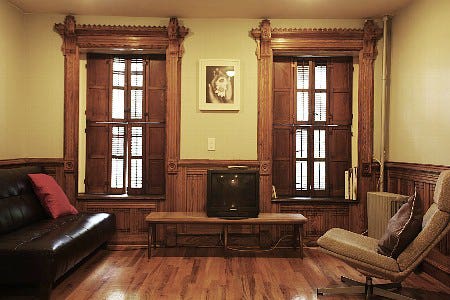
Clem Labine
Loving Old Houses to Death
The very success of the old-house revival may be causing great harm to the historic nature of old houses themselves. That alarming situation is certainly emerging in brownstone Brooklyn, and I wonder if others are observing the same phenomenon in other parts of the U.S.
This issue came into sharp focus by activity just a few blocks from my home in Brooklyn’s Park Slope section. A young couple has just purchased an 1890s brownstone that had all of its original interior detail intact. But instead of rejoicing in its pristine Victorian elegance, the couple brought in an architect who has gutted the entire house, replacing finely detailed woodwork and plasterwork with a minimalist Modernist interior.
This is no isolated phenomenon. Throughout the “Brownstone Belt,” young buyers are “modernizing” their newly purchased historic row houses.
Here’s the kind of thing that’s happening. After paying over $1 million to buy the house, an architect is hired to remake it completely. Any vintage wainscoting and architectural millwork go into the dumpster at the curb – followed by all the lath and plasterwork.
All windows are replaced, enlarged or both. Some floors are removed altogether to create double-height rooms. Many, if not all, interior walls are removed, and the back masonry wall is torn out and replaced with an all-glass “window wall.” Plaster is chipped off the brick common walls to create a rustic “bare brick" look (thereby vastly increasing sound transmission to and from the neighbors). A rooftop bulkhead is added for the elevator (an essential!). The building is expanded with a rear addition to accommodate the gym, dog-grooming room, sauna and spa that are also must-haves.
Reuse and restore has become reject and renovate
Even in historic districts, just about all these actions are legal. But, to me, most of them register as cultural crimes. If a buyer wants modern amenities, why not get them in any of the hundreds of new condo buildings where these features are built in? Why destroy a historic building’s irreplaceable craftsmanship and construction materials in pursuit of today’s transitory Modernist fashions?
This insensitivity to historic interiors has roots in the very success of the brownstone revival. In the 1960s and '70s, brownstone pioneers (I was one) bought old run-down row houses because no one else wanted them and prices were cheap. We couldn’t afford expensive makeovers, and, in the process of modest DIY renovation and restoration, we learned to love and respect the historic character of these old houses. The concept of stewardship emerged naturally.
Over several decades, this restoration activity also created pleasant, livable, human-scale neighborhoods that eventually became fashionable, and prices began to soar. As a result, most of today’s buyers who are paying seven figures for a brownstone see themselves as merely buying a desirable community – not a historic one. These young buyers have money, know what they want – and want it now. They outline their ideas for an extreme makeover to their architect before ever moving in. Very few have any concept of stewardship of historic architecture, and, indeed, once the interior is gutted, there is little worthwhile to preserve for future generations. The old building henceforth will be merely an envelope to contain a succession of makeovers in whatever fashion is current.
William Morris declared in 1889: "These old buildings do not belong to us only. They belong to our forefathers, and they will belong to our descendants unless we play them false.”
This stewardship concept has clearly not penetrated many of today’s old-house buyers in Brooklyn. Is it that way in other parts of the U.S.? Please let me know in the comments section. Thanks!
Clem Labine is the founder of Old-House Journal, Clem Labine’s Traditional Building, and Clem Labine’s Period Homes. His interest in preservation stemmed from his purchase and restoration of an 1883 brownstone in the Park Slope section of Brooklyn, NY.
Labine has received numerous awards, including awards from The Preservation League of New York State, the Arthur Ross Award from Classical America and The Harley J. McKee Award from the Association for Preservation Technology (APT). He has also received awards from such organizations as The National Trust for Historic Preservation, The Victorian Society, New York State Historic Preservation Office, The Brooklyn Brownstone Conference, The Municipal Art Society, and the Historic House Association. He was a founding board member of the Institute of Classical Architecture and served in an active capacity on the board until 2005, when he moved to board emeritus status. A chemical engineer from Yale, Labine held a variety of editorial and marketing positions at McGraw-Hill before leaving in 1972 to pursue his interest in preservation.








